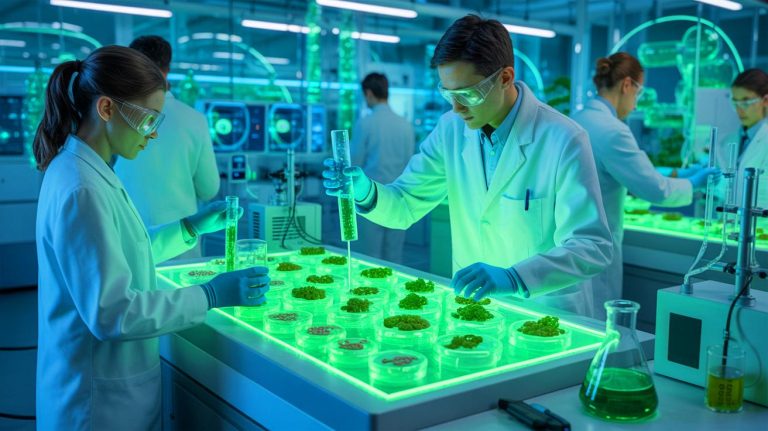| IN A NUTSHELL |
|
In recent years, the quest for sustainable energy solutions has taken an exciting turn with the development of bio-batteries. These innovative devices harness the power of electroactive microorganisms to generate energy. Scientists in China have made significant strides by developing a miniaturized, portable bio-battery that offers precise bioelectrical stimulation and self-charging capabilities. This revolutionary advancement promises to transform how we think about energy storage and conversion, paving the way for a more environmentally friendly future.
Bio-Battery Maintained a High Viability
The development of bio-batteries marks an exciting advancement in the field of sustainable energy technology. The research team, as published in Advanced Materials, has created a miniaturized bio-battery using living hydrogels. These hydrogels, which are 3D printable into various shapes, contain conductive biofilms encapsulated in an alginate matrix. This innovative design ensures the bio-battery maintains a high viability of over 70% throughout its operation, with a remarkable 97.6% at the end.
The living hydrogels retain key biological properties, such as electroactivity, which facilitate electron generation and the reduction of graphene oxide. This ensures efficient energy conversion, making bio-batteries a promising alternative to traditional energy storage systems. The research highlights the potential of bio-batteries for practical applications, offering a new direction for sustainable power supply.
Harnessing Engineered Living Materials for Energy Application
One of the key highlights of this research is the utilization of engineered living materials to drive sustainable energy conversion and storage. Bio-batteries have emerged as a pivotal solution in this domain, offering an environmentally friendly alternative to conventional batteries. Inspired by lithium-ion battery design, the researchers developed a bio-battery using living hydrogel as the bio-anode ink and K3[Fe(CN)6]-containing alginate hydrogel as the cathode ink.
The bio-battery’s capacity to charge capacitors ensures a precise and controlled electrical energy supply, essential for effective nerve stimulation. Although its specific capacity and energy density are lower than traditional lithium-ion batteries, the bio-battery’s sustainable approach, avoiding critical raw materials like cobalt and lithium, underscores its importance. By eliminating environmentally hazardous components, such as manganese and organic electrolytes, the bio-battery represents a significant step toward sustainable energy solutions.
Scientists Fabricated Living Hydrogel into Standard 2032 Battery Shell
In an impressive feat, researchers successfully fabricated the living hydrogel into a standard 2032 battery shell. This innovation showcases the bio-battery’s self-charging performance and exceptional electrochemical capabilities. The device demonstrates a coulombic efficiency of 99.5%, maintaining high cell viability exceeding 90% after operation.
This breakthrough paves the way for advanced bio-energy devices, supporting portable applications with immense potential for future sustainable energy technologies. By targeting the sciatic and vagus nerve, the bio-battery enables precise bioelectrical stimulation and physiological blood pressure control. This precision technique holds promise for developing novel physical therapy methods, highlighting the bio-battery’s versatility and potential impact across various fields.
| Parameter | Bio-Battery | Lithium-Ion Battery |
|---|---|---|
| Specific Capacity | 0.4 mAh/g | 150 mAh/g |
| Maximum Power Density | 8.31 µW/cm² | 200 µW/cm² |
| Energy Density | 0.008 Wh/L | 250 Wh/L |
| Coulombic Efficiency | 99.5% | 85-90% |
The developments in bio-battery technology signal a promising future for sustainable energy solutions. With high viability, efficient self-charging capabilities, and environmentally friendly materials, these bio-batteries hold the potential to revolutionize energy storage. As researchers continue to explore and refine these devices, one must wonder: How will bio-batteries reshape our approach to energy in the coming decades, and what new possibilities will they unlock?
Did you like it? 4.4/5 (21)







Is this battery like a tiny power plant? 🏭
99% efficiency? That’s insane! Are there any downsides?
China is always coming up with something shocking. 🤯
How does this compare to Tesla’s batteries?
Can these bio-batteries power a car? 🚗
How long until we see these in consumer products?
Sounds good, but what’s the catch? 🤔
Thank you for the informative article!
This sounds like science fiction becoming reality. 🌌
What happens when the bacteria die?
Hope this doesn’t lead to a zombie apocalypse. 🧟♂️ Just kidding!
Can we expect a drop in battery prices soon?
Do these batteries need to be charged in any special way?
How safe are these bio-batteries for the environment?
Is this technology scalable for large power grids?
I’m curious about the cost of production.
Wow, this could be a game-changer for renewable energy! 🌍
Are there any ethical concerns with using living materials?
Are there any potential health risks for humans or animals?
Hope this isn’t just another overhyped tech.
Love the emojis in the article! Makes it fun to read. 😊
How long do these batteries last compared to lithium-ion ones?
This article was so well written, thank you!
Could this technology be used in space exploration? 🌌
Does this mean we can finally stop mining for lithium?
When can we expect this to be available for purchase?
Can these batteries be recycled?
How much energy can one of these bio-batteries store?
China is leading in tech innovation again! 🇨🇳
is there any patent issue with this tech?
Is this the end for lithium-ion batteries?
Hope this can help reduce e-waste. 🌱
How robust are these batteries in extreme weather? 🌦️
Could this tech be integrated into wearable devices?